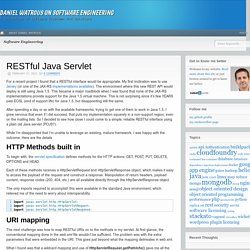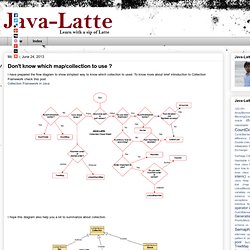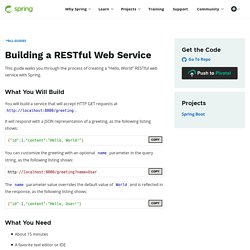

Daniel Watrous on Software Engineering. For a recent project I found that a RESTful interface would be appropriate.

My first inclination was to use Jersey (or one of the JAX-RS implementations available). The environment where this new REST API would deploy is still using Java 1.5. This became a major roadblock when I was found that none of the JAX-RS implementations provide support for the Java 1.5 virtual machine. This is not surprising since it’s few YEARS past EOSL (end of support life) for Java 1.5, but disappointing still the same. After spending a day or so with the available frameworks, trying to get one of them to work in Java 1.5, I grew nervous that even if I did succeed, that puts my implementation squarely in a non-support region, even on the mailing lists. While I’m disappointed that I’m unable to leverage an existing, mature framework, I was happy with the outcome.
To begin with, the servlet specification defines methods for the HTTP actions: GET, POST, PUT, DELETE, OPTIONS and HEAD. Gunnar Hillert's Blog: REST with Spring - ContentNegotiatingViewResolver vs. HttpMessageConverter+ResponseBody Annotation. Disclaimer: This blog posting reflects experiences while learning to implement RESTful services.

Thus, certain elements of my blog posting may turn our to be not correct. Therefore, if you encounter errors, please let me know and I will post corrections as soon as possible. Please proceed with caution... As I posted in my previous blog "Making DevNexus.com more Restful", I am in the process of making more of the data from DevNexus.com consumable by other services, by exposing JSon and XML based endpoints.
Java-Latte: Don't know which map/collection to use? I have prepared the flow diagram to show simplest way to know which collection to used.

To know more about brief introduction to Collection Framework check this post I hope this diagram also help you a lot to summarize about collection. If you know anyone who has started learning java, why not help them out! Spring Finance > Part 7: Adding support for JSON and XML views. It has been a while since I have updated the Spring Finance Manager sample application so I thought it’s time to do it now.

Since my last article a few of the dependencies have cut new milestone releases. Ajax Simplifications in Spring 3.0. In my last entry, I walked you through several enhancements in Spring 3 for web application development.

A number of you expressed interest in a follow-up entry focused on Ajax remoting. Spring 3 provides a lot in this area to take advantage of. Read on, and I'll walk you through it. Spring and Ajax Overview For the purposes of this article, when I say Ajax, I'm talking about the web browser's ability to communicate with a web server asynchronously using JavaScript. Spring-finance-manager - Spring Finance Manager sample application. HyTech – OAuth2: The Resource Owner Password Flow. The third OAuth2 flow that we’ll cover as part of this series is the Resource Owner Password Flow.

We’ve covered the OAuth2 Authorization Grant Flow and the OAuth2 Implicit Flow so far. We’ve also seen how client applications can refresh expired access tokens. The Resource Owner Password Flow is really pretty simple, as it allows the client to exchange a user’s username and password for an access token. Woah….. what? Yes, it means the client applications, let’s say an Android app will really need ask for the username and password.
Now that the trust issue seems to be solved, there’s still one thing that an API provider should not do wrong when it is offering the OAuth2 Resource Owner Password Flow: offer no refresh tokens. Here at hybris, we’ve been using Basic Authentication over HTTPS for the OCC Web Services, our commerce-driven RESTful web services. So let’s look at the flow diagram from the OAuth2 spec for the Resource Owner Password Flow: Short, isn’t it :-) Let’s look at the code: Getting Started · Building a RESTful Web Service. In Spring’s approach to building RESTful web services, HTTP requests are handled by a controller.

These components are identified by the @RestController annotation, and the GreetingController shown in the following listing (from src/main/java/com/example/restservice/GreetingController.java) handles GET requests for /greeting by returning a new instance of the Greeting class: Understanding Spring Security – Part 1 – Introduction. July 26th, 2012 by Amitabh Adhikari Spring Security, formerly known as Acegi Security, is an open source security provider that is used extensively in Java based web applications.

Due to its power and ability to be customized, Spring Security has evolved itself into the de-facto standard for securing Spring-based applications. The purpose of this blog series is to examine Spring Security 3.0, as well as provide informational resources into its various functions. Spring security targets two main areas of web application, these are “authentication” and “authorization.” Authentication refers to the process of establishing that a principal is who they claim to be. Securing a RESTful Web Service with Spring Security 3.1, part 3.